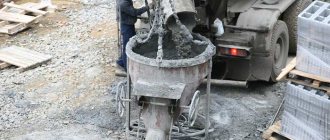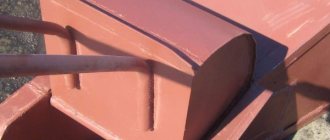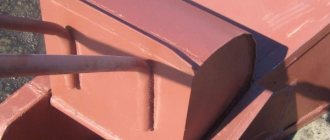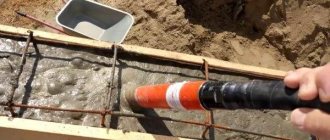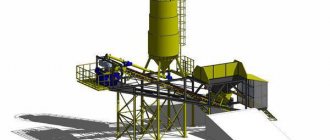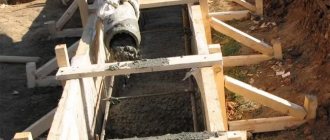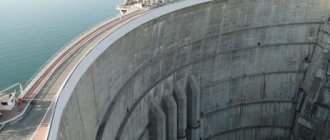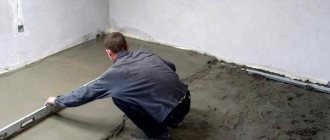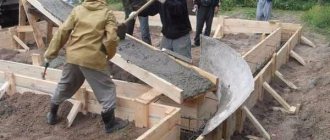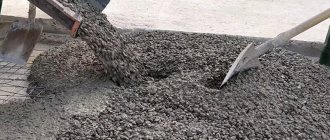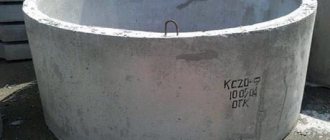How does concrete get into formwork?
One of the most critical stages in the construction of monolithic reinforced concrete structures is the delivery of concrete from the mortar-concrete unit to the place of its installation.
How concrete is delivered to the placement site Gone are the days when the concrete mixture was delivered to the construction site by dump trucks; now concrete is transported by domestic and imported concrete trucks of various capacities. Using this delivery method can significantly increase the life of concrete, since throughout the entire trip the mixing drum of the concrete truck rotates slowly (3 - 4 rpm), mixing the mixture, and almost fresh concrete arrives at the site. However, now the concrete mixture delivered to the construction site must be brought into place and poured into the formwork. Two main methods of supplying concrete are used here:• the traditional method: “crane-tub”, in which the concrete delivered to the construction site is poured into a rotating tub, laid in a horizontal position with the shutter closed. A construction crane turns the filled tub into a vertical position, lifts it and carries it to the place where it is poured into the formwork, where the shutter is opened and concrete is poured into the formwork;• a relatively new method of laying concrete using a concrete pump. In this case, the concrete mixture from a concrete truck is poured into the receiving hopper of a mobile (trailer) or truck-mounted concrete pump, which delivers the mixture directly into the formwork through concrete pipes. The power of modern concrete pumps allows the mixture to be supplied to a height of up to 100 m and a distance of up to 300 m. Both of these methods are used on domestic construction sites with equal success, and each of them has its own characteristics and, accordingly, areas of application.
Concrete pumps are high-performance modern equipment for laying concrete. Of course, the use of concrete pumps significantly reduces labor costs during concrete work, but its high productivity (up to 80 m³/hour) makes the use of such equipment economically justified only for significant volumes of concreting. At the same time, a situation may arise when it is necessary to concrete a structure to which the existing crane cannot supply concrete and it is necessary to either rent a crane with a long boom, which has a high lifting capacity with a large reach, in order to supply a bucket of concrete to this place, or use a concrete pump. In such a situation, a truck-mounted concrete pump can be used, which, thanks to a boom reaching a length of 60 m, can in a short time concrete a structure that is inaccessible to a construction crane of medium lifting capacity. For concreting large-area floors, mechanical or hydraulic mobile concrete dispensing booms are used, allowing the mixture to be supplied within a radius of 12 to 40 m from the boom installation point. At the same time, the use of concrete pumps has its own characteristics, in particular, the pumped concrete mixture should not contain aggregates with a fraction larger than 40 mm, in addition, the concrete must have a certain plasticity (cone slump) and it must be supplied continuously, otherwise the concrete pipes must be regularly cleaned of the mixture remaining on their walls. Despite these features, the use of concrete pumps significantly speeds up the process of laying concrete and allows concreting structures of significant volume in a limited time.
Which method should you choose? However, the “crane-tub” method, due to its simplicity and efficiency, is still successfully used on many construction sites, where the bulk of the construction is made up of structures with a relatively small volume, in particular multi-storey and individual residential buildings. For industrial construction or the construction of unique public centers or shopping complexes, it most often turns out to be economically justified to use a concrete pump. In any case, the method of supplying concrete, as well as the equipment and equipment necessary for this, must be selected at the stage of developing a concrete work project, taking into account economic and technological factors.
xn—-ptbbjegddbnkmk.xn--p1ai
What types of containers are there according to application?
The solution tub is usually universal. It allows you to store, transport, mix and supply concrete mixture. However, according to their purpose, containers can be divided into 2 large groups: for supplying and stirring the solution.
For supplying concrete and mortar
As a rule, the tub is equipped with gutters for supplying the finished building mixture. An indispensable attribute on any site. With the help of this type of equipment, the solution retains the desired consistency for some time; besides, the main task of the container is to ensure its supply to different parts of the construction site and even floors.
To mix the solution
This type of solution tub is usually accompanied by a special tray. The capacity can reach 2000 liters, but when mixing the mixture it is never 100% filled. To load the components inside, use a cement truck or concrete mixer. Since at large sites a concrete mixer usually copes with the task of preparing the solution, this type of container is used in the construction of cottages, low houses, warehouses, individual walls and ceilings.
Purpose and design of the “Shoe” concrete bucket
There are two forms of container design: rectangular and cone-shaped. The first form is a “Shoe” tub for concrete, the second is a “Glass”. The shape of the “shoe” is a rectangle turning into a cone and really resembles this type of shoe. The hopper is loaded in a horizontal position with the shutter closed and fixed, and transported and used in a vertical position. Hence its additional name - rotary bunker. The rotation is made using lifting mechanisms.
This device opens at the bottom of the cone using a lever system, which provides regulation of the dose of concrete solution. In addition, the locking mechanism has a lock that prevents spontaneous opening. A folding chute serves to guide the pouring; To deliver the concrete mixture to hard-to-reach places, a rubberized hose is connected.
The handle for opening the hopper is offset and this allows you to visually control the concreting process. The design is stable in any position. If necessary, an electric vibration motor is installed on the “shoe”, in the area of the cone. Then the tub can be used for transporting rigid concrete and dry mixes. The advantage of this design is that the loading height in a horizontal position is low and it is possible to load concrete mortar from any type of concrete mixer.
Construction tub for concrete mixtures 'Shoe'.
A device for moving bulk cargo is a skimmer. We have come into use with the old word tub, which is really more suitable for the designation of the structure being described.
Portable bunker-tub for mortar concrete mixture.
Construction organizations use more than one type of tub, which differ in design and internal volume.
A description with fragments of personal drawings of the 'Shoe' concrete mix tub is offered in the following description.
The production of the tub (cubel) was based on the documents of GOST 21807-76 in compliance with the specified parameters and recommendations.
The 'Shoe' type bucket for concrete mix is by far the most convenient to use. Its loading opening is made to size for loading directly from a concrete mixer or concrete mixer. The concrete solution is loaded when the tub is in a horizontal position. The shutter is in the closed state at this time. After loading, the tub of mortar is transported by a crane or hoist to the technological process site, where workers use the concrete mortar mixture in doses or all at once.
Description of the design of the portable bunker 'Shoe' for concrete mixture.
The 'Shoe' tub is made in volumes from 0.5m3 to 8m3. You can independently make a tub for any required volume.
Here is an example of our concrete mortar bucket.
The body of the hopper is made of hot-rolled sheet metal 6mm thick from steel grade VSt3ps in accordance with GOST 380. When manufacturing a larger-volume bucket, the wall thickness must be increased. The entire perimeter of the body is reinforced with a metal corner 45x45x5 (VStp3s GOST - 380), which acts as stiffening ribs, and in the lower part of the tub structure, the frame from the corner acts as a mounting platform for the shutter valve. On one of the walls of the tub body there is a platform for a low-voltage electric vibrator.
The shutter valve of the bucket is rotary, segment-type, easily doses the flow of concrete mixture and reliably keeps the concrete solution in the bucket hopper from spontaneous emptying. When the valve moves, it does not jam due to single components of the concrete filler (crushed stone, gravel, slag, expanded clay) getting into the mechanism, since the valve, during closing, slides along the guides of the valve neck and pushes out excess solution and everything that gets into the gap between the valve valve and edge of the bolt neck.
The shutter lever lock is not indicated on the drawings. It can be of any type.
The longer the lever, the lighter, but the less convenient. A short lever is more convenient, but it is difficult to control the bolt mechanism. The control must be made in such a way that the force directed to the lever when closing the bucket shutter does not exceed 6 kgf (60N).
All structural parts of the tub, except for the bunker, are made removable and can be replaced or repaired at any necessary time. Of course, your 'Shoe' tub can be assembled using a welded joint, but I will immediately warn you that equipment sometimes breaks at a construction site. A tub will fall from a certain height. Deformed. What if she comes with a solution? This is where collapsible connections will come in handy. Replace or repair only the damaged part. All costs will be lower.
Like other construction equipment, the tub must be cleaned of mortar after use and the valve and its mechanism must be washed. Inspect externally for cracks, tears and the condition of the lifting hinges.
Let me remind you that the drawings are amateur and made for a personal archive, but at the request addressed to me more than once, I am sharing its fragments with everyone.
Manufacturing
The process of preparing the mortar is a labor-intensive construction operation. That is why the trough for preparing the batch should be highly durable and easy to use.
Let's consider one of the possible design options. For manufacturing you will need the following materials:
a metal sheet. It is advisable to use sheet steel measuring 1000x2000 mm, with a thickness of at least 1 mm, and having a zinc coating. The dimensions of the steel sheet may vary. The main thing is that the volume of the container corresponds to the assigned tasks;
Making a container for preparing a solution from sheet metal
- coniferous wood in the form of boards with a thickness of 30 to 50 millimeters. Prepare one board about 6 meters long, which will allow you to make a trough with dimensions of 1x2 m;
- nails for making a wooden frame or self-tapping screws for fixing steel sheets to boards.
When making a trough for concrete with your own hands, perform the work in the following sequence:
- Cut a solid six-meter board into 4 pieces: two pieces 2 meters long and two 1 meter long.
- Round the edges along the radius on two-meter workpieces, sawing off the corner fragments.
- Nail galvanized steel sheet to the straight parts of the prepared planks using nails.
- Bend the edges of the sheet at the level of the radius part and, using self-tapping screws, fix the meter-long boards.
- Additionally, secure the structural elements with self-tapping screws, which will increase the service life and ensure tightness.
Considering the small overall dimensions and weight, transporting such a container for concrete is not difficult. The radius shape of the sheet at the ends makes it easier to remove the finished solution and clean it. The tightness of the structure is achieved after the initial mixing, when the cement mortar seals small cracks. After the concrete mass hardens, water will not be able to flow out.
After the first batch, the trough will become almost airtight due to the filling of the cracks with concrete mortar
This design option is simple and allows the use of available building materials. Such a trough is a completely complete device for preparing concrete.
What types of concrete containers are there depending on the material?
A concrete bucket is a hopper with a valve, handles, clamps and transport loops. The hinges are needed so that the solution tub can be lifted using a crane. The capacity of the container can vary from 500 to 2000 liters.
Metal
Construction tubs for mortar are produced from special construction steels that meet the requirements of GOST 27772-88. For the manufacture of containers, welding is used, so not all grades of steel are suitable as materials, but only those that combine strength, impact strength and weldability: 09G2S, 12GS, 16S. Moreover, the thickness of the steel sheet is at least 2.5 mm.
Plastic
A concrete bunker should not only be highly durable, but also have anti-corrosion properties. Therefore, steel is the main material. For home construction work, the use of steel containers in accordance with GOST 380-74 is allowed, but not on a professional construction site. Only boxes and trays for solution are made from high-strength plastic.
Some features of the operation of construction devices
As noted above, it does not always make sense to purchase a bucket; sometimes it is much easier to rent one or even use the services of transporting concrete, since doing the work yourself will require too much effort.
This applies to many jobs, for example, cutting reinforced concrete with diamond wheels without special equipment will take too much time and money, and diamond drilling of holes in concrete is a completely impossible task without expensive devices. It is much easier to use the services of professionals who will carry out the work quickly and efficiently.
The paint must be periodically renewed, as the layer is severely damaged during use.
Criterias of choice
From the description it follows that the simplest, therefore the most inexpensive, but quite capacious design are all types of “Boxes”. At the same time, the most convenient (from the point of view of transportation, loading and unloading and the ability to move bulk materials) tub is considered to be a rotating “Shoe”. “Ryumka” is recommended to be used in combination with small-scale mechanization equipment: chutes, concrete pumps and feed hoses.
In general, it makes sense to have at the construction site: a “Shoe”, a “Glass” and several “Boxes” of various capacities and designs, depending on the scale of the construction and the volume of planned concrete work.
Mortar bunker in Russia
- EBPOTEX company
- Krasnodar
- 7 (988) 2468222
- https://www.evroteh.info
from 35,000 to 40,260 rub/piece
from 27,100 to 46,000 rubles / piece
- TD Aver
- Omsk
- 7 (962) 0585875
- oooaver.com/?ycl >
from 22,000 to 26,000 rub.
- Gemiol LLC
- Moscow
- +7
- RosTechMash
- Mines
- +7
- https://www.rostechmash.ru
- Stroy-Agregat
- Moscow
- +7
- Avilor LLC
- Moscow
- +7
- https://www.220ww.ru
- TGN
- Saint Petersburg
- +7
- https://www.tgn93.ru
- Plant RemStroyDorMash
- Kazan
- +7
- Tekhnostroy
- Tyumen
- +7
from 28,000 to 120,000 rubles
- Ecosystem Company LLC
- Ekaterinburg
- +7
- https://www.eko-ekb.ru
- MetalStroyKit
- Naberezhnye Chelny
- +7
- https://www.ooomsk.com
- Donstalkanat
- Bataysk
- +7 (86354) 7-03-70
- https://www.doncan.ru
- LLC PF Kronos-T
- Tyumen
- +7
- EnergoMash
- Taganrog
- +7
- Stroymashservice-Msk
- Moscow
- +7
- https://www.smsm.ru
from 21,500 to 41,000 rubles
- PKF Techno-GSK
- Moscow
- +7
- Elsie-story
- Rostov-on-Don
- +7
- Ural Construction Equipment Plant
- Ekaterinburg
- +7
- Himkor
- Ekaterinburg
- +7
- https://www.himkor.ru
- 1 review
- Stroypark Plus
- Saint Petersburg
- +7
- https://stroyparkpl.ru
from 170,000 to 400,000 rubles
- FSUE NPP Progress
- Omsk
- 7
from RUB 6,000/set
- EBPOTEX company
- Krasnodar
- 7 (988) 2468222
- https://www.evroteh.info
from 24,054 to 47,786 rubles / piece
- On the Propartner portal you can:
- buy a hopper for solution in Russia wholesale and retail;
- see the cost of a solution bunker: the price from companies in the catalog is from 1,600 to 400,000 rubles.
Registering is very easy, it only takes 15 seconds
Source: www.propartner.ru
Article rating:
Save to:
Hopper for supplying solutionLink to main publication
Advantages and disadvantages of designs
Each model has its own characteristics, pros and cons. Some fixed-type models use both vertical and horizontal methods of loading concrete. At the bottom of the hopper there is a tray, it is usually made in the shape of a cone. Despite the identical dimensions, the pyramidal container is higher, but it is more difficult to clean the inner surface of solution residues.
In small designs, the bottom tray is most often opened manually. Large containers use locking connections.
Rotary models are more expensive, but also more comfortable to use. When using a “shoe”, supplying the solution requires fixing the structure at the desired angle to the support, this makes the work easier. It is possible to adjust the speed of supply of the mixture from the container. This type of design is more versatile, with increased convenience provided by the large cross-sectional area for the funnel.
Among the disadvantages of the “shoe”, it is worth noting the possibility of loading concrete only in a horizontal plane using two methods - using a dump truck or special vehicles. Thus, the “bell/glass” design is simpler and cheaper, while the “shoe” design is functional and comfortable, but costs more. The first option is suitable for small volumes of work, the second is relevant when performing large-scale fills.
A bucket for supplying concrete is a convenient and functional device that greatly simplifies and speeds up the pouring of concrete at sites. Provided the correct choice and professional operation, the bunker will serve for a long time and faithfully.
Features of the rotary tank
A bucket for concrete with horizontal loading is called a shoe (type BP). Its distinctive feature is the change in the position of pouring the concrete mixture. Reception from transport is carried out in a horizontal plane, and movement and supply of the mixture into the formwork is carried out vertically or at any convenient angle. Due to the design features of such a container, its weight can be higher than that of a fixed tub of the same volume.
The body of the shoe is divided into three parts:
- Rectangular receiver for concrete or mortar mixture.
- Bunker in the form of a truncated pyramid.
- Two-section valve that regulates the angle and intensity of the solution supply.
Receiver and hopper
The receiver for the mixture and the shoe hopper are most often made of rolled metal. Part of the body, made in the form of a truncated pyramid, is additionally strengthened by a longitudinal frame made of channels, which prevents deformation of the structure when fully loaded.
Hinges for working with lifting equipment are mounted on a frame made of channels. The reinforcing frame is supplemented with special elements - drives, which ensure the tilting of the container during concreting or unloading the solution.
The shoe is equipped with a special shutter, both doors of which have their own control handle. Thanks to this design, it is possible to regulate the supply of the mixture. To prevent accidental opening of the shutter, the handles are equipped with special safety rings.
Taking into account the structural features, the mixture cannot always be unloaded without additional impact. Therefore, a shoe-shaped concrete bucket suggests the possibility of using a mounted vibrator.
Taking into account the weight of the structure itself and the volume of the container up to 3 m3, such devices are most often used to supply a mortar mixture. The cost of a tub of this type varies from 30 to 90 thousand rubles, depending on the maximum volume.
Criteria for choosing containers for concrete
To ensure optimal performance of construction work, compliance with technology, and ease of use of the container, a number of the following factors must be taken into account:
the dimensions must be suitable for carrying out all necessary manipulations in specific conditions; the capacity should be optimally compared with the scale of the concreting work, so as not to cause delays and to prevent idleness of the finished mixture; when choosing a shoe, you need to make sure that the required equipment can be used, the equipment is equipped, as well as the methods of attaching the sleeve or funnel; it is important that the lifting capacity is sufficient to ensure increased safety on the construction site, but taking into account the characteristics of the crane used; It is recommended to choose a branded manufacturer that guarantees high build quality, durability and reliability of the design (it is worth paying attention to Zitrek products).
Renting or buying?
- large amount of work;
- a tight or round-the-clock work schedule that does not allow downtime;
- it is necessary to make some changes to the scheme, for example, to strengthen the frame;
- are engaged in commercial activities and often perform work related to concreting: pouring sites or constructing multi-story monolithic buildings.
If you decide to buy a new tub, you will receive the following benefits:
- the design will fully meet the declared characteristics: absence of hidden or obvious defects, deformation of the container;
- it will be possible to maintain the ideal condition of the metal by ensuring gentle operating conditions and timely maintenance;
- loading the exact volume of solution, since there will be no dry concrete adhering to the walls.
Buying a used tub is an excellent alternative to purchasing a new one due to the following benefits:
- at the same price it will be possible to get larger container sizes;
- instead of a fixed shoe, choose the optimal shoe and improve work productivity;
- abandon Chinese equipment in favor of branded equipment, for example, Zitrek;
- operation at the maximum technical capabilities with minimal financial investments.
Used equipment that has been in use for a year has a cost that is 1.5-2 times lower than new equipment with similar characteristics. Therefore, from a financial point of view, it is the most profitable. The following risks are present:
- ideal external condition is the result of hiding critical defects, for example, rusted sheets or a supporting frame;
- inside steel structures, as a result of improper operating conditions, fatigue deformations have formed, which, under certain loads of the concrete mixture, partially or completely destroy the tub;
- There must be a technical passport.
In case of a limited budget or one-time concreting, renting is beneficial. Its cost depends on the service life of the equipment, its condition, design features and equipment. If there is a long distance to the construction site, then it is necessary to evaluate the possibility of purchasing, since sometimes transportation costs can make renting financially unprofitable.
Prices for new and used concrete buckets
| Type of service | Type | Volume | Load capacity, t | Dimensions, m | Price, rubles |
| Purchase (new) | Fixed with unloading tray and funnel clamp | 0,5 | 1,12 | 1.50x1.50x1.46 | 18900 |
| 1,5 | 3,75 | 1.52x1.52x2.00 | 29950 | ||
| Fixed with tray | 3 | 4,5 | 1.57x1.57x2.85 | 48800 | |
| Rotating with a platform for installing a vibrator | 1,6 | 4 | 3.60x1.60x0.89 | 36900 | |
| 2 | 5 | 3.70x2.10x1.14 | 45400 | ||
| Purchase (used) | Rotary | 0,5 | 1,12 | 3.1x1.27x0.7 | 15500 |
| 1,6 | 3,75 | 3.10x1.27x1.20 | 16000 | ||
| 2 | 4,00 | 3.60x1.27x1.34 | 19500 | ||
| Fixed | 0,5 | 1,25 | 1.25x1.25x1.27 | 10000 | |
| 0,75 | 1,88 | 1.25x1.25x1.68 | 14500 | ||
| 2 | 5 | 1.58x1.58x2.45 | from 19000 | ||
| Rent | Rotary | 1 | 2,5 | 3.17x1.27x0.72 | from 800 per day + 12000 deposit |
| 2 | 5 | 3.64x1.27x1.34 | |||
| Fixed | 0,5 | 1,5 | 1.25x1.25x1.27 | from 500 per day + 10,000 deposit | |
| 1 | 2,5 | 1.25x1.25x1.86 | |||
| 2 | 5 | 2.00x2.00x1.75 |
MANUFACTURER'S WARRANTY
9.1. The manufacturer must ensure that the bunkers comply with the requirements of this standard provided that the consumer complies with the conditions of transportation, storage and operation established by the standard.
9.2. The guaranteed service life of the bunker is at least a year from the start of operation, but no more than 18 months from the date of shipment from the manufacturer.
1. DEVELOPED AND INTRODUCED by the State Committee of the Council of Ministers of the USSR for Construction Affairs
K. M. Konstantinov (topic leader), V. I. Smolin, B. B. Tikheev, M. F. Krainyuk, B. V. Zhadanovsky
2. APPROVED AND ENTERED INTO EFFECT by Resolution of the State Committee of the Council of Ministers of the USSR for Construction Affairs dated April 28, 1976 No. 59
3. Inspection frequency 5 years
4. INTRODUCED FOR THE FIRST TIME
5. REFERENCE REGULATIVE AND TECHNICAL DOCUMENTS
6. REISSUE (June 1988) with Amendment No. 1, approved in June 1985 (IUS 1-88).
Purpose and varieties
A tub may be needed when the volume of loading and unloading concrete is very large. When pouring monolithic foundations and other structures, the bunker makes it possible to significantly reduce the cost of delivering the finished mixture, eliminating the need for the services of a plant and providing the solution directly to the site. Ready concrete can be stored in the tub for some time.
Different models of buckets are suitable for implementing certain tasks, so before choosing, it is advisable to study the features of each option.
Glass or bell
This is a model of a fixed cylindrical tub with a cone. The bunker carries out vertical supply of concrete. The stability of the structure is achieved thanks to the presence of a support system in the format of wide rings. The rings are different, the configuration is different in the case of a filled and empty container.
The concrete solution is loaded into the bucket through the top from a dump truck. It's easiest to work with lowered models. The standard configuration assumes the presence of jaw-type locking connections, which are located in the lower part of the cone. Also, to simplify the supply of the solution, mechanisms are used: a trailed tray, a funnel, and fasteners for flexible hoses.
The “bell” model is used to load concrete mortar into similar/monolithic building structures. This type of tub is useful when working with very hard mixtures. Additional functionality is provided by replaceable trays and special hoses, without which concrete supply is only possible in one direction.
“Ryumka” is the simplest and most inexpensive version of a tub, the capacity varies in the range of 0.5-3 cubic meters (more can be found in Moscow, but rarely), the average carrying capacity is 2500 kilograms.
Tub in the shape of a shoe
This model is made with a rotating structure, the geometry of which can change. The capacity is 1-4 cubic meters, the hole for receiving concrete is rectangular, the mixture is unloaded horizontally, which guarantees comfort in operation and stability of the tub.
Externally, the model looks like a tapering and slightly truncated pyramid. The unloading funnel is closed with a special shutter, the body is reinforced with metal parts. The special frame provides additional protection and stability.
The main feature of the “shoe” model is the presence of a vibrator on either side of the tub, which significantly extends the life of the solution and allows it to be stored for a short time. The mixture becomes more homogeneous and active, and is easier to serve.
Cranes are used to move the tub and rotate it into a vertical plane. Thanks to the rotating type of design, the task is greatly simplified. This is a more functional model compared to the previous one. An important advantage is the connection of a vibrator, which does not allow concrete to linger on the walls of the container.
Discharge funnels in “shoe” type models can be very different – from slide to two-section. A system of levers initiates control. Using a bucket, concrete can be prepared directly on site.
Cone-shaped container design
A shot glass-shaped concrete bucket is a universal device for working with a mixture of any mobility. Builders often call this device a “bell.”
The tub is positioned only vertically and is not intended for tilting or turning (type BN), therefore the outlet funnel of the container is often equipped with special trays or a sleeve to facilitate the supply of concrete or mortar mixture.
The body of the container in the form of a glass is a receiving cylindrical hopper, turning into a truncated cone. The narrowed lower part creates a funnel effect, which greatly facilitates the passage of concrete or mortar mixture under its own weight.
The cylindrical part is usually reinforced with special channels encircling it in the upper and lower parts. Thanks to these elements, the concrete tub perfectly tolerates the loading of slow-moving mixtures that exert great pressure on the walls of the container. It is to the channels that the metal loops for working with the crane are attached.
The support of the container is made in the form of a circle, due to which the tub of the glass is highly stable on any surface. The tray is made in the form of a round gutter, the fastening of which is carried out at an angle. The tilt ensures that the container is unloaded when the mixture moves independently under the influence of gravity.
Volume and price
Most often, such a tub is made with a volume of 1 – 3 m3. The cost of the device on average ranges from 15 to 65 thousand rubles, so in low-rise construction it is best to rent a tub, which will cost 500 - 800 rubles per day.
Criteria for selecting buckets for supplying concrete
When purchasing a new product, pay attention to the following:
- For the desired capacity of the bunker: for buckets of the BN series it starts from 0.5 m3, for buckets of the BP series – from 1 m3. Volume gradation – every 0.2 m3.
- For the thickness of the metal of the bunker: rolled thin sheets will significantly reduce the service life of the product, taking into account the fairly high density of concrete mixtures and the operating conditions of the products at the construction site.
- On the quality of painting of all surfaces: the use of weather-resistant powder paints not only ensures the tightness of the coating in any atmospheric conditions (at least for a year), but also guarantees the durability of the equipment.
- For the presence of additional options in the design of the tub. In particular, the presence of a platform for installing a vibrator (for products such as a bell and a shoe) will speed up the process of unloading concrete and will reduce the complexity of subsequent cleaning of the internal surface of the bunker. For non-rotary versions, the convenience of unloading is also determined by the type of mechanism for opening the shutter jaws.
- Shape of transport eyes. It should be convenient for use when transporting the tub not only with cranes, but also with forklifts.
For periodic concrete work, buckets for pouring concrete are usually not purchased, but rented. The rented container must not have dents on the inner surface of the bunker, damage to the coating or defects in transport loops.
ACCEPTANCE RULES
5.1. Each bunker must be accepted by the technical control of the manufacturer.
5.2. When accepting bunkers, check:
appearance indicators;
dimensions of the bins, correct installation of clamps and hinges;
density of overlap of the discharge opening of the valve;
possibility of spontaneous opening of the shutter;
quality of welds;
quality of paint and varnish coatings.
5.3. The consumer has the right to carry out a control random check of the compliance of the bunkers with the requirements of this standard, while observing the sampling procedure and control sequence specified below.
5.4. For a control spot check, one bin of each standard size is selected from the batch. A batch is considered to be the number of bins supplied simultaneously to one consumer, but not more than 10 pcs.
5.5. During selective inspection, in addition to the requirements set out in clause 5.2, the strength of the hinges and their welds is checked for a load exceeding the permissible by 25%.
5.6. If, during a control check, at least one bunker does not meet the requirements of this standard, the consumer has the right to inspect each bunker of this batch.
5.7. At the request of the consumer, the manufacturer is obliged to present acts of control random inspection of bunkers.
Review of the most popular options and their advantages and disadvantages
As noted above, there are mainly two types of structures used, and you need to decide which one is suitable for a particular construction project
They differ in many characteristics, and it is important to choose the best option
Shot glass design
A bucket glass for concrete is one of the simplest types of products, which provides invaluable assistance in the process of work. But you need to understand that products of this type may differ from each other, and choosing a specific option can be difficult, even if you do not buy, but rent the device. After all, productivity and ease of use depend on the right decision.
It was the appearance that determined the name of the glass (some call this type a bell)
Let's consider what criteria you should pay special attention to, whether purchasing new equipment or used units:
The material used to make the product, most often steel, must be very durable. Insufficient thickness does not provide the required reliability
If you choose a used tub, then pay attention to the absence of damage; sometimes eliminating them will cost more than the product itself.
Also check other elements - each unit must be strong and reliable.
If you need a device with a capacity of 1 m3, you should not purchase an option twice as large: it is much heavier, and it will be inconvenient to work with.
A bucket for supplying concrete of this type consists of several main parts:
- The main container, made either simply in the shape of a cone, or as a cone with a cylinder on top. The features of this system depend on the required capacity.
- The support system is also of great importance; it can be of a wide variety of configurations. The main requirement for it is the strength and stability of both empty and full containers.
- A very important part of the design is the shutter with a handle with which the solution is unloaded; the shutter must be durable and the opening handle comfortable. (See also the article Cladding aerated concrete: how to do it.)
A comfortable valve handle is an important part of the design
Eyelets for attaching the structure to the crane and lifting it are very important, since the safety of everyone on the construction site directly depends on it.
Shoe type design
This is a more progressive option, but its price is noticeably higher; the requirements for strength and quality of materials for such structures are similar to those discussed above. (See also the article Concrete crushed stone: features.)
Instructions for checking the product yourself are as follows:
- First, all structural elements are carefully inspected for reliability and absence of damage.
- If the unit is used, then look inside the bunker: if it has not been cleaned, then a layer of hardened concrete can create a lot of problems for you.
Due to its external features, this type of design is called a shoe or galosh
This option has a number of advantages:
- The design of the product is rotary, which allows you to adjust the direction of unloading concrete and increases the ease of use of the bucket. It is this advantage that determines the popularity of this type of product.
- The structure may have a platform for installing a vibrator, which significantly speeds up the unloading process and prevents concrete from sticking to the walls.
- Another undoubted advantage is the ability to load the solution both from a mixer and from a dump truck; this can simplify the work and reduce the cost, since special transport is much more expensive than conventional trucks.
- Despite the large capacity and reliability of the products, their unloaded weight is relatively small, which increases ease of transportation.
- Loading such containers is much easier, since this is done with the tub in a horizontal position (transportation is carried out in a vertical position).
Convenience of loading the container is another important advantage
CONTROL METHODS
6.1. The appearance (and shape) of the bins is assessed by inspection.
(Changed edition, Amendment No. 1).
6.2. The correct dimensions of the body, lifting loops, shutter and installation of a device that prevents its spontaneous opening must be checked with a metal tape of the 2nd accuracy class in accordance with GOST 7502-80.
6.3. The tightness of overlap of the discharge opening of the gate is checked with the gate fully closed for the presence of a gap between the hopper body and the gate. The gap is allowed no more than 3 mm.
6.5. The quality of paint and varnish coatings is determined according to GOST 5233-67.
6.3; 6.4. (Changed edition, Amendment No. 1).
